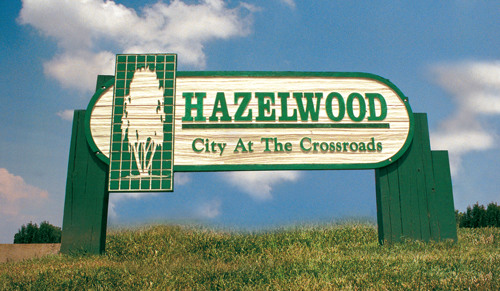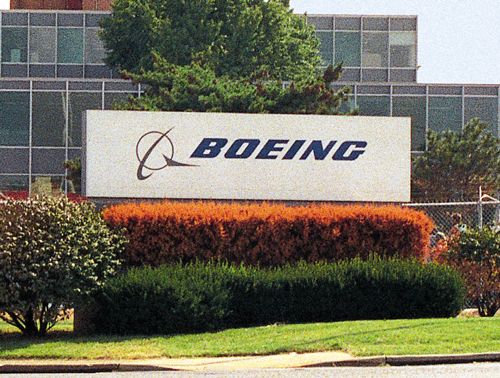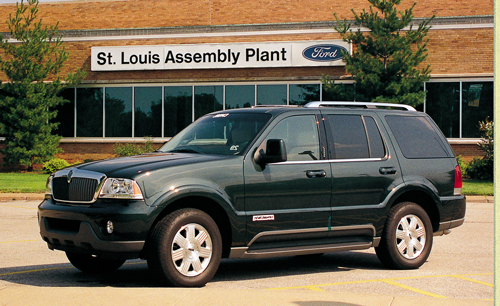Community Profile: Hazelwood, Mo., Is a City At The Crossroads
Photo Gallery | Article
Photo Gallery


Defense remains a viable ingredient in Hazelwood's economic mix, with Boeing Co. continuing to operate several plants in the town.

Ford Motor Co.'s Hazelwood assembly plant employs more than 2,800 people.
If you want to get a quick read on the economic future of the St. Louis suburb of Hazelwood, look at the signs—the ones near the city’s borders.
Although Hazelwood’s current municipal motto is “Crossroads of Progress,” the white and green signs adorned with trees still bear the town’s former slogan, “City at the Crossroads.”
In both cases, the word “crossroads” applies to Hazelwood’s prime location—two interstates and a county thoroughfare pass through the city, and a third interstate runs close by. But the mottoes could just as easily describe the economic decisions that civic leaders grapple with as they face the possible loss of a Ford Motor Co. assembly plant. The plant employs more than 2,800 people and contributes 18 percent of the city’s tax revenue.
Ford announced in January that the plant would be one of five U.S. plants axed by mid-decade to save money. A 22-member task force, which includes state, city, economic development and union officials, has been working to come up with proposals to change Ford’s mind. The task force knows the impact goes far beyond Hazelwood. More than 8,000 other jobs in the area would be lost because of the closing’s ripple effect, according to Angela Holden, an economist at the University of Missouri-St. Louis. In all, more than $500 million in annual wages would be threatened and more than $200 million in annual tax revenue would be jeopardized, she estimates.
“Like a Kick in the Stomach”
Ford’s announcement felt “like a kick in the stomach,” says Ken Dearing, president of United Auto Workers Local 325. But the workers have endured uncertainty before. In 1994, the plant’s future looked shaky after nine years of producing Ford’s Aerostar minivan because of competition from other minivans and the upstart sport utility vehicles. Ford’s own Explorer SUV rode to the rescue. Realizing it needed a location to supplement its Louisville plant’s Explorer production, Ford selected Hazelwood.
Today, the Explorer remains among the nation’s top-selling SUVs, despite problems with Firestone tires and increasing competition in this category. Assuming the Explorer’s sales do decline, Ford officials say a new product would have to rise from the ashes and replace the Explorer’s position on Hazelwood’s assembly lines.
A glimmer of hope comes from a new luxury SUV—the Lincoln Aviator—that Hazelwood was chosen to produce. Although the Aviator’s production and sales numbers aren’t expected to reach Explorer-like figures, the new work is putting Hazelwood in a more positive spotlight and giving plant workers an opportunity to put on a show that they hope will change the parent company’s mind.
“We’re doing everything in our power to make sure this is the best launch that Ford has ever had, in terms of safety, efficiency and quality,” Dearing says.
Members of the task force working to save the plant are also looking at other moves to give Ford more incentive to stay put. Missouri officials are trying to entice more suppliers to the state. Union officials are discussing restructuring the plant itself, which currently builds vehicles on a single platform. The Louisville plant is able to use two different platforms to build vehicles.
Building an Economic Defense
In the 1980s, the loss of the Ford plant wouldn’t have been such a blow to Hazelwood, which was building its economic dreams around a different kind of aviator. McDonnell Douglas Corp., which has since been bought by Boeing, served as the cornerstone of a glittering array of industrial and manufacturing jewels in north St. Louis County, where Hazelwood is located. Thousands of defense jobs at McDonnell pumped a steady stream of revenue into Hazelwood coffers.
But the double punch of the early 1990s recession and of defense cutbacks was staggering for McDonnell, resulting in thousands of layoffs during the first half of the decade. It was a blow, but not an economic knock-out for the North County region, says Mark Tranel, a professor at the University of Missouri-St. Louis and head of the economic development subcommittee of North County Inc., a non-profit group promoting the region’s economic growth.
“Certainly, the layoffs had an impact, but North County is still disproportionately represented by manufacturing activity,” Tranel says. “There’s a lot to sell in North County, but there’s an image challenge due to the residual impact of these economic changes on the housing and retail markets.”
Hoping to attract more housing, North County Inc. recently sponsored a reception for developers. Tranel noted that the region struggles with two perceptions that he sees as myths: first, that North County is “out there,” far away from the core center of metropolitan St. Louis and, second, that the region is “built in,” with few spaces left for development.
From Boeing to Biotech
Defense remains a viable ingredient in the town’s economic mix. Boeing maintains its defense and space operations in North County, with several plants in Hazelwood. But Boeing’s not the only defense game in town. Last year, just as Boeing planned to close two of its plants, global aerospace supplier GKN Aerospace Services bought one of the Boeing facilities and moved its North American corporate headquarters to Hazelwood. GKN, which employs 1,395 in Hazelwood, makes metal and composite parts for military and commercial aircraft.
Hazelwood is seeking smaller industrial and manufacturing firms, too. Like many other cities, it hopes to take advantage of the growth in biotechnology. It’s already attracted bioMerieux Inc. and Aesculap Inc., both of which manufacture medical instruments.
Space for new business abounds, thanks in part to tracts of land that have been bought and cleared by nearby Lambert St. Louis International Airport for noise abatement. New development areas include Lambert Pointe, positioned as a corridor for high-tech and biotech businesses, and the Robertson redevelopment area, 180 acres near the airport that Hazelwood Mayor T.R. Carr hopes will become a business park for suppliers to Ford.
Saks on a Floodplain
In the past, retail establishments have not been a major part of Hazelwood’s economy. But that’s about to change in a big way. Mall developer Mills Corp. recently broke ground for a $250 million shopping center dubbed St. Louis Mills. The 1.2 million-square-foot mall will include 12 anchor stores. Hazelwood city leaders approved $18.7 million in tax increment financing for the project.
The mall, being constructed on part of a Missouri River floodplain, will be anchored by high-end outlet stores, led by the St. Louis area’s first OFF 5th—the outlet version of Saks Fifth Avenue.
Rebecca Zoll, executive director of North County Inc., sees the Mills development as an epic event for the region, perhaps permanently changing its economic make-up and the perceptions of outsiders.
“This will bring in people from around the Midwest, and their dollars will go back into our community,” Zoll says. “There’s been some concern about how the mall will affect local business, but I think it will only help.”
Residents Feel the Squeeze
St. Louis Mills promises to provide a boom in retail dollars for Hazelwood, but until then, the city is feeling a budget pinch, even before Ford potentially packs up and moves. As part of a national dispute between Ford and the cities that house its auto plants, the automaker recently sued Hazelwood, claiming it has overpaid its taxes and is owed $1.2 million.
With the final outcome of the suit still in question, Hazelwood officials are anticipating the worst. At the same time, they are planning for a possible future loss of annual tax revenue from Ford, estimated at $3 million a year. Earlier this summer, the city considered turning its police service over to St. Louis County. Vocal opposition from residents helped quash that proposal, but their opposition didn’t translate to support for a 44-cent increase in the property tax rate, which lost by 60 votes on the August ballot. The city then implemented a 10-cent rate increase—the maximum allowed under state law without voter approval—and cut its limb-chipping and leaf-vacuuming programs. City Hall also warned that other city services might have to be reduced or eliminated if revenue doesn’t pick up.
Despite the budget crunch and his city’s uncertain economic future, Mayor Carr finds reason for optimism as he stands at the crossroads. “We have an incredible economic base, and we are a financially healthy city,” he says. “Even if Ford were to leave, Hazelwood has a bright economic future.”
Hazelwood, Mo., by the numbers
| Population (2000 Census) |
26,289
|
| Labor Force (July 2002) |
16,149
|
| Unemployment Rate (July 2002) |
4.4 percent
|
| Median Household Income (2000 Census) |
$45,110
|
| Top Employers (June 2002) | |
| Ford Motor Co. |
2,800
|
| GKN Aerospace Services |
1,395
|
| IBM Corp. |
1,110
|
| Mallinckrodt Inc. |
921
|
| Boeing Co. |
823
|
Views expressed in Regional Economist are not necessarily those of the St. Louis Fed or Federal Reserve System.
For the latest insights from our economists and other St. Louis Fed experts, visit On the Economy and subscribe.
Email Us


